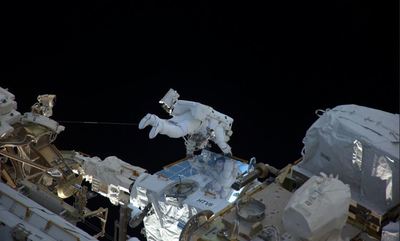 |
ESA astronaut Thomas Pesquet completed his first spacewalk together with NASA astronaut Shane Kimbrough to complete a battery upgrade to the outpost’s power system.
Thomas is seen here at the external pallet of Japan’s HTV-6 supply ship retrieving battery adapters to install closer to the Station’s solar arrays.
Thomas commented on the picture: “I was holding on carefully to the International Space Station: I grew attached to it.”
Photo courtesy of European Space Agency (ESA) / Roscosmos / O. Novitsky |
| |
European Space Agency, France - February 8, 2017
A novel way of using ESA’s CryoSat mission has revealed how lakes beneath Thwaites Glacier drained into the Amundsen Sea – potentially the largest such outflow ever reported in this region of West Antarctica.
This new information is helping scientists understand more about what’s going on deep below the surface of the ice and what affects how fast the glaciers flow towards the ocean.
Thwaites and its neighbouring Pine Island Glacier are the fastest-receding glaciers on the Western Antarctic Ice Sheet.
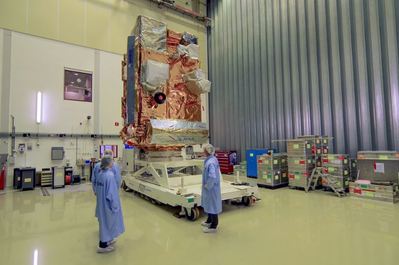 |
MetOp-C payload module
The payload module of MetOp-C, Europe’s latest weather satellite, is in place at ESA’s technical centre in the Netherlands for rigorous testing in space-like conditions.
Photo courtesy of European Space Agency (ESA) / ETS / A. Kuebler |
| |
Although this huge sheet is some 2 km thick in places, much of its floor is well below sea level.
This makes it is particularly vulnerable to change, especially where the warmer ocean waters meet the underside of the floating terminus of the glacier.
Understanding the movements of these glaciers is critical for predicting how the ice sheet may behave in the future and how it may affect sea level.
A paper published today in The Cryosphere explains how CryoSat measurements have been processed in a new way and reveal that, in 2013, four interlinked lakes under Thwaites drained into the ocean.
http://www.the-cryosphere.net/11/451/2017/
 |
European Space Agency (ESA). Training up
Photo courtesy of ESA |
| |
Lakes have been found under glaciers in many parts of Antarctica and are, indeed, commonly associated with fast-flowing glaciers.
However, this is the first time they have been found and observed draining into the Amundsen Sea.
In addition, this emptying is thought to happen only every 20–80 years.
Water below the ice sheet plays an important role in how quickly glaciers flow towards the sea, thought to be because a layer of meltwater reduces friction between the ice and the bedrock.
In addition, when channels form under the ice they lubricate the glacier bed.
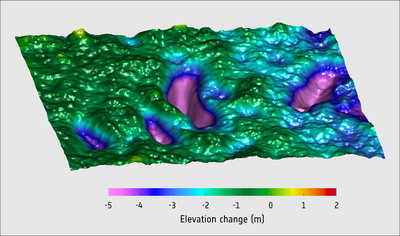 |
Four lakes under Thwaites
Photo courtesy of ESA |
| |
Benjamin Smith from the University of Washington and lead author of the paper said,
“This is first time we’ve been able to monitor both elevation changes and ice speed in this kind of detail over such a large area.”
“Without a satellite like CryoSat, we would have probably have missed the lake draining and we would have had to guess how the lake drainage might have affected the ice speed.
“Together, they tell us about how water moving at the glacier bed affects ice speed, and what processes we need to understand so that we are better equipped to predict the future of Thwaites.”
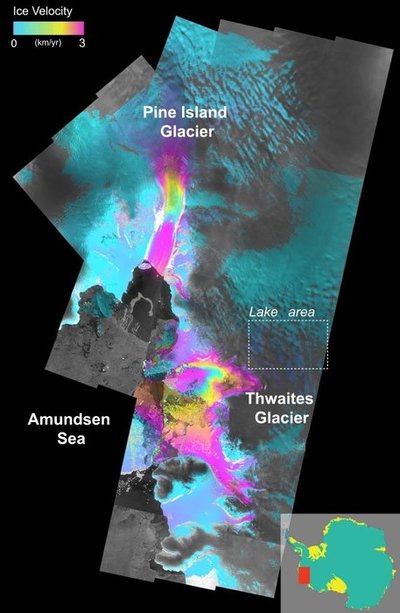 |
Glacier speed West Antarctica
Photo courtesy of ESA |
| |
Noel Gourmelen from the University of Edinburgh explained,
“Repeat observations from CryoSat over Thwaites revealed that the surface of the ice subsided by several metres as water drained away from the four lakes under the ice. The lakes totalled an area of about 700 sq km.”
“On average, Thwaites carries about 135 cubic km of ice to the sea every year, but drainage from these lakes released an extra 3.5 cubic km of freshwater.”
“In addition, the speed of the glacier increased by about 10% and would have contributed to a discharge of around 150 cubic km a year between 2013 and 2014.”
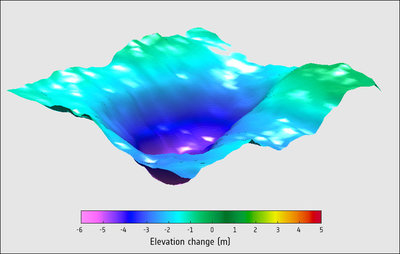 |
One of four lakes under the glacier
Photo courtesy of ESA |
| |
Drainage is estimated to have peaked at about 240 cubic m a second, possibly the largest outflow of meltwater ever reported from subglacial lakes in this region.
This peak rate is about four times faster than the River Thames in England discharges to the North Sea each year.
Before this discovery, scientists had thought that this part of the ice sheet did not store water in lakes beneath the surface for very long because abrupt drainage had not been seen before in the area.
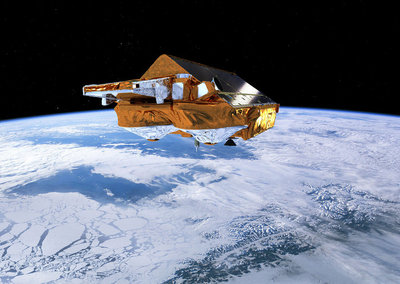 |
ESA's ice mission
Photo courtesy of ESA |
| |
Mark Drinkwater, head of ESA’s Earth observation mission science, said,
“Previous studies have investigated if CryoSat could be used for monitoring small vertical displacements associated with these events.”
“The main issue has been the limited coverage of standard altimeter measurements. But thanks to new processing techniques, the capability of using CryoSat to both discover and monitor Antarctic subglacial lakes has vastly increased.”
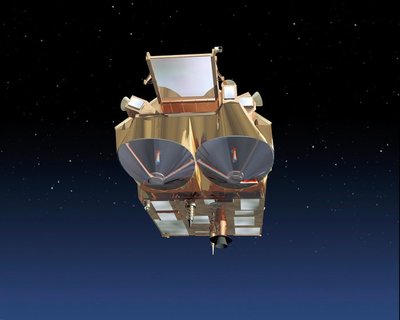 |
CryoSat front view
Photo courtesy of ESA |
| |
Tommaso Parrinello, ESA’s CryoSat mission manager, added,
“CryoSat again is proving what a versatile satellite it is. Now we also have the Copernicus Sentinel-1, with both providing powerful tools for developing further understanding of the relationship between lake drainage and ice dynamics in Antarctica.”
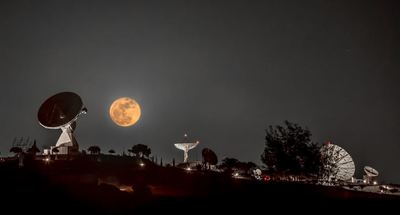 |
Winter Moon
This gorgeous image shows this month’s full Moon, also known as a ‘Cold Moon’, seeming to hover above a set of satellite tracking dishes on the campus of the Instituto Nacional de Tecnica Aerospacial (INTA), in the southern part of the Canary Islands’ Gran Canaria, at Montaña Blanca.
One of the antennas – the 15 m-diameter dish seen at left – is ESA’s Maspalomas tracking station, which currently communicates with ESA’s Cluster, LISA Pathfinder and XMM-Newton missions.
Photo courtesy of ESA / Claus Vogl |
| |
Source: European Space Agency (ESA)
http://www.esa.int/ESA
ASTROMAN Magazine - 2017.02.07
NASA Highlights Science Launching on Next SpaceX Cargo Mission
http://www.astroman.com.pl/index.php?mod=magazine&a=read&id=2190
ASTROMAN Magazine - 2016.12.03
Part-Time Scientists and Audi lunar quattro ready to head for the Moon
http://www.astroman.com.pl/index.php?mod=magazine&a=read&id=2165
ASTROMAN Magazine - 2016.09.11
Airbus Defence and Space's PerúSAT-1 satellite ready for take-off
http://www.astroman.com.pl/index.php?mod=magazine&a=read&id=2118
ASTROMAN Magazine - 2016.08.14
UAE Space Agency, Mubadala and Lockheed Martin Launch Comprehensive Space-based Workforce Development Program
http://www.astroman.com.pl/index.php?mod=magazine&a=read&id=2105
ASTROMAN Magazine - 2016.04.09
SpaceX's Falcon 9 rocket will launch the CRS-8 Dragon Spacecraft Mission for NASA
http://www.astroman.com.pl/index.php?mod=magazine&a=read&id=2053
ASTROMAN Magazine - 2015.10.02
Flight VA226 success: with Sky Muster and ARSAT-2 in orbit, Arianespace serves Australia and Argentina
http://www.astroman.com.pl/index.php?mod=magazine&a=read&id=1972
ASTROMAN Magazine - 2015.07.26
Airbus Defence and Space to build JUICE spacecraft, ESA's next life-tracker inside the Solar System
http://www.astroman.com.pl/index.php?mod=magazine&a=read&id=1941
ASTROMAN Magazine - 2015.07.18
Boeing's 10th GPS IIF to Modernize Worldwide GPS System
http://www.astroman.com.pl/index.php?mod=magazine&a=read&id=1940
ASTROMAN Magazine - 2015.06.14
Boeing to Build Third All-Electric Propulsion Satellite for ABS to Australia, New Zealand, t he Middle East, Russia, South Asia
http://www.astroman.com.pl/index.php?mod=magazine&a=read&id=1929
ASTROMAN Magazine - 2014.10.18
Boeing-built X-37B Orbital Test Vehicle Successfully Completes 3rd Flight
http://www.astroman.com.pl/index.php?mod=magazine&a=read&id=1812
ASTROMAN Magazine - 2014.05.17
6th Boeing GPS IIF Spacecraft Reaches Orbit, Sends 1st Signals
http://www.astroman.com.pl/index.php?mod=magazine&a=read&id=1714
ASTROMAN Magazine - 2014.02.22
5th Boeing GPS IIF Spacecraft Sends Initial Signals from Space
http://www.astroman.com.pl/index.php?mod=magazine&a=read&id=1659
ASTROMAN Magazine – 2013.04.14
Boeing X-48C Blended Wing Body Research Aircraft Completes Flight Testing
http://www.astroman.com.pl/index.php?mod=magazine&a=read&id=1443
ASTROMAN Magazine – 2013.04.02
Boeing to Demonstrate Innovations in Space and Cyberspace at National Symposium
http://www.astroman.com.pl/index.php?mod=magazine&a=read&id=1433
ASTROMAN Magazine – 2012.12.15
Boeing's Reusable, Unmanned X-37B Orbital Test Vehicle Begins 2nd Flight
http://www.astroman.com.pl/index.php?mod=magazine&a=read&id=1366
ASTROMAN Magazine – 2012.10.15
Intelsat Accepts 2nd On-Orbit Boeing 702MP Satellite
http://www.astroman.com.pl/index.php?mod=magazine&a=read&id=1333
ASTROMAN Magazine – 2012.08.09
Boeing Flies X-48C Blended Wing Body Research Aircraft
http://www.astroman.com.pl/index.php?mod=magazine&a=read&id=1292
ASTROMAN Magazine – 2012.06.19
2nd Boeing-built X-37B Orbital Test Vehicle Successfully Completes 1st Flight
http://www.astroman.com.pl/index.php?mod=magazine&a=read&id=1257
ASTROMAN Magazine – 2012.06.08
Boeing, Raytheon and Harris to Pursue GPS Control Segment Sustainment Contract
http://www.astroman.com.pl/index.php?mod=magazine&a=read&id=1252
Editor-in-Chief of ASTROMAN magazine: Roman Wojtala, Ph.D.

